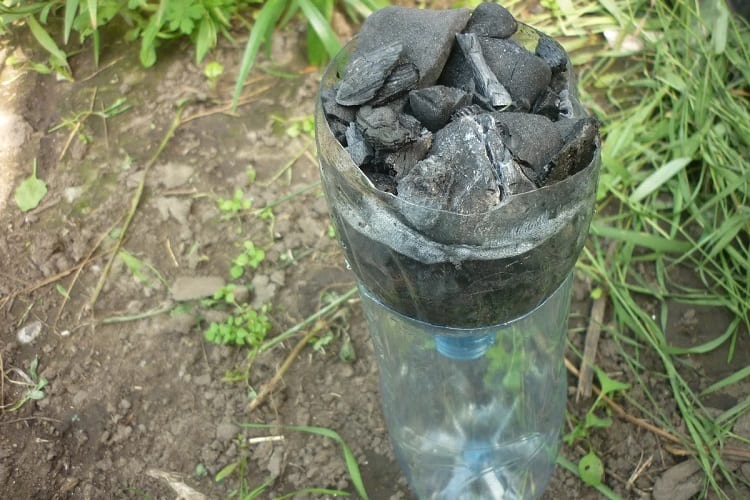There is zero question that you cannot live even in the best of times without this one thing. It’s water. You can go without eating for weeks but drink unsafe water or go without it for even just a few days, and you could end up dead very quickly. More people have died from bad water than from lack of food throughout history. There are emergency options that involve crafting a funnel and filtering water to keep you safe and hydrated in bad times. Some stones, sand, charcoal, and a couple of bottles are all it takes to make sure you have safe water when needed.

Access to two plastic water bottles or large leaves and two items found near almost every camping spot, charcoal, and small stones, is what will ensure the water is filtered and made clean. Other things exist that can be used to craft a filter in a pinch.
If you take away one thing from this article, fresh, clean water is the single most valuable thing on the planet. A survival water filter can often ensure you have it.
Why Is It so Important to Filter Water?
Water is essential, but it can also kill. It isn’t the water killing you but all of the tiny organisms you can’t see that need it just like you do. When we were young, most of us were taught that boiling water kills those organisms and makes the water safe, which is true. We don’t always have access to a way to boil water, either due to no heat source or no vessel to hold the water in.
That stream or river might look clear and clean, but it still could be hazardous. A stream running quickly down rocks can be tremendously safer than any slow-moving or stagnant water, but it still doesn’t come with a guarantee or a money-back sticker. Filtering water from that fast-moving stream can be just as crucial to your survival as properly filtering a stagnant water source.
Every year, water-related illness kills 3,575,000 people. That is one person every 10 seconds or a jumbo jet crashing every 60 minutes. Of those, 2.2 million will be children. Many people credit beer with saving the world during the Dark Ages when the water supply in most nations was so contaminated that the heating of water in the brewing process killed the potential for getting cholera and kept people alive. Yes. Beer saved the world.
Little things are swimming around in unfiltered water, and those little things might kill you.
Water filters work because they create a barrier that blocks debris. They also trap bacteria from passing through. Charcoal is the perfect water filter because it removes toxins but doesn’t remove valuable nutrients. It works through a process called adsorption, not absorption. Adsorption binds impurities chemically, and it is technically the process of adding molecules from the water to a solid. Due to adsorption, the dangerous creatures found in most water in nature are removed while the water tastes better. Charcoal filters are often the filter of choice for households to further improve clean water coming in through the traditional sewer system.

The Survivor’s Water Filter
Making a DIY activated charcoal filter isn’t hard to do and could save your life.
Many guides tell you this is the second part of the process, but that’s wrong. Before everything else, have charcoal available and a way to crush it. If it’s from a very recent fire or a grill use, it needs to be thoroughly cooled first. Preferable is recently used charcoal.
Crafting from a leaf, wood, or an old water bottle makes the filter. Most important is crafting a funnel where water flow is slow and controllable. Add the charcoal. On top of the charcoal, pack sand or grass, further aiding the filtering process.
A plastic water or soda bottle is ideal for making a filter. Cut off the bottom end of the bottle to pack in the charcoal, sand, and rocks. Poke a small hole in the cap to control water flow and start filtering.
Start Filtering
Pour the river, lake, or groundwater into the funnel. It will filter down slowly through the sand, rocks, and charcoal. Repeat the process until the water is as clear as you desire. Boiling the water after filtering can ensure the most sterile results, as it will kill any remaining microscopic organisms that might have made it through the filtering process.
The drawback to using this process is that it can take quite some time to filter the water, and water comes out as a drip or very slow pour while traveling through the many layers. Repeating this several times further slows the results. Still, the benefits are worth the wait, as getting sick from water-borne organisms can be deadly, as discussed earlier.
Making a filter is a last resort when needed. Water filtration straws are essential in a survival kit. They do not take up much room, and they do not need to be filtered multiple times. Many people will swear they can drink right from muddy puddles.
No matter how you accomplish it, water filtration in the wild is essential. Plan on it as a necessary skill. Whatever the technique, do it with all water sources to ensure your’s and your family’s health.
How’d we do? Do you have any other techniques that have worked well for water filtration? We’d love you to share them in the comments below.


[lasso rel="emergency-preparedness-more-a-manual-on-food-storage-and-survival-2nd-edition-revised-and-updated" id="35334"]